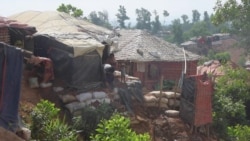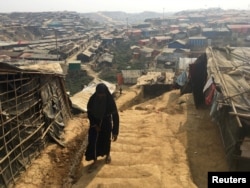When Halima Khatun, an ethnic Rohingya refugee, fled to Bangladesh to escape a military crackdown in her homeland in neighboring Myanmar last year, she set up her small shelter of sticks and plastic sheeting on the edge of a precarious cliff - the only space she could find.
But eight months later, that cliff is falling apart amid the start of Bangladesh's annual rainy season, and Khatun fears her home may soon be washed away from the precipice.
"We didn't look if it was flat or hilly because we just needed shelter," she told VOA. "Now with the rainy season, we are putting down sandbags, but they are falling down. The hill is collapsing."
The Rohingya fled en masse from Myanmar last year, with some 700,000 escaping violence that the United Nations said was ethnic cleansing, an allegation denied by Myanmar.
But now, stormy weather brings another challenge for the beleaguered Rohingya, who live in crowded refugee camps in the hills near the Myanmar border.
May and June bring cyclones and monsoons to southeastern Bangladesh. Aid groups warn the harsh weather will cause landslides, floods, and disease outbreaks in the refugee camps.
The season's first small storms have already wrought destruction as strong winds knocked down shelters.
Refugee Rukiya Begum said she had to take shelter in another house after strong winds tore away the plastic sheet from her house during a recent storm.
"In this small rain, I was not able to stay in my house," she said. "So when the heavy rains come, what will happen?"
Already, low-lying areas have turned to muck, but when the June monsoons come, much of the camp is expected to flood, risking the contamination of drinking water with latrine overflow.
"It's already hard to have proper hygiene for people, and it's just going to become more complicated because of lack of access to clean water, because of the mud," said Marcella Kraay, project coordinator for Doctors Without Borders in the refugee camps.
The wet weather also increases risk of landslides on steep, unstable hillsides. The soil is thin, and has been made even looser because the refugees seeking land to build on and firewood for cooking have nearly deforested the area.
Already, multiple refugees already have died in small landslides, including nine-year-old Hossain Johar, who was killed when he sought shade under a small overhang that collapsed.
"They burned down our houses [in Myanmar]. We could not stay there," said Johar's father, Abdul Noor. "But my son died after coming here. I'm thinking, 'how has this happened?"
In hopes of mitigating damage, aid workers are handing out extra bamboo poles and plastic sheets to the refugees to help them strengthen their huts.
Bangladeshi volunteers also teach the refugees how to strengthen their shelters, showing the new arrivals resilient housing designs and knot-tying techniques.
"What we saw in recent wind and rain, the families who got our support did not have any damage," said Monirul Alum, one of the volunteer instructors.
But bamboo and tarps may not be enough to survive the biggest storms.
In those cases, the only real solution is for people to move to safer ground. On the western edge of the camp, over 2,000 workers flatten hills using shovels to make space for families to relocate from hillsides and flood prone areas.
"Our main focus is to save people from water and drowning and the landslides," said Mohammad Faruque, the site supervisor. "Our main target is to bring the people before the monsoon comes."
But even if the work finishes before the heaviest rains begin in June, the new site can accommodate fewer than 20,000 people. No one has been moved to that location yet, leaving the vast majority of at-risk refugees at risk without a place to go.
Still, Mohammad Abul Kalam, an official with Bangladesh's Refugee Relief and Repatriation Commission, downplayed the threat of the rains, noting that better drainages being built in the camps may reduce the need to move some people.
Kalam also noted that the Rohingya managed to survive the end of the monsoon season last year in Bangladesh.
"I think we'll be able to protect the entire population as we did the last months," he said. "These people encountered at least one third of the rains last year, from August to October, so they are already familiar with the conditions here."
But Rohingya refugee Mamah Tahsien, whose hillside hut suffered damage in recent rains, was not optimistic.
"If it rains, if there is wind, the house will be destroyed," he said. "If I could get a better place, I would go."








